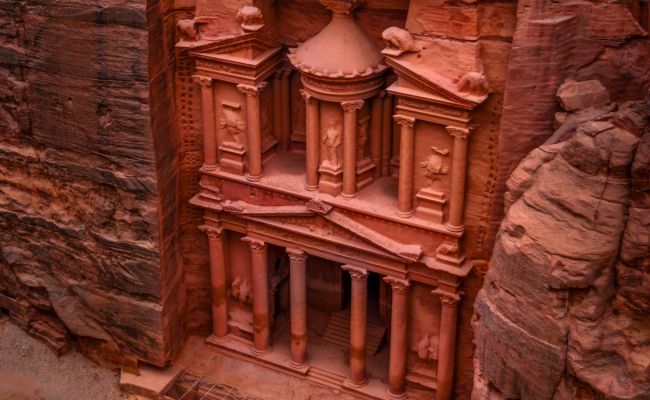Petra, sometimes known as the “Rose-Red City” because of the unique color of its rock-cut buildings, is an ancient archaeological site in southern Jordan. The Nabataean Kingdom constructed Petra as its capital in the fourth century BC, nestled in a depression among the steep mountains of the Jordanian desert.
Petra, known for its beautiful rock-cut tombs, temples, and complicated water management systems, flourished as a major commerce hub, connecting the East and West via a network of caravan routes. Petra, a UNESCO World Heritage Site since 1985 and one of the New Seven Wonders of the World continues to attract visitors with its historical relevance, architectural splendor, and ancient people’s inventiveness. This introduction lays the groundwork for delving into Petra’s rich history, amazing architecture, and lasting cultural heritage.

History
Built as the capital of the Nabataean Kingdom in the fourth century BC, Petra, located in southern Jordan, boasts a rich history. The Nabataeans, an Arab tribe skilled in trade and engineering, turned Petra into a bustling economic hub by controlling the lucrative incense, spice, and silk trade routes that linked Arabia, Egypt, Syria, and the Mediterranean. The city’s strategic location, along with the Nabataeans’ superior water management infrastructure (dams, cisterns, and aqueducts), enabled it to thrive in the harsh desert environment.
Petra peaked in the first century AD when its population grew and its construction became more ornate, as evidenced by the renowned Al-Khazneh (the Treasury) and Ad Deir (the Monastery). The Roman Empire seized Petra in 106 AD, and the city continued to flourish. However, trade routes moved throughout time, and earthquakes in the fourth and sixth centuries AD exacerbated their collapse. By the medieval period, the Western world had virtually abandoned and forgotten Petra, until Swiss adventurer Johann Ludwig Burckhardt rediscovered it in 1812. Today, Petra is a UNESCO World Heritage Site and one of the New Seven Wonders of the World, attracting millions of visitors who are fascinated by its historical and architectural significance.
Integrity
The preservation of Petra, a UNESCO World Heritage Site since 1985, demonstrates its remarkable worldwide value and historical significance. The Nabataeans carved Petra into the brilliant rose-red sandstone cliffs of southern Jordan over 2,000 years ago, creating a unique blend of ancient architecture and cultural legacy. The preservation of its exquisite rock-cut monuments, such as the renowned Treasury (Al-Khazneh) and Monastery (Ad Deir), sustains its integrity, serving as outstanding examples of Nabataean engineering and creative excellence.
However, natural erosion from wind and water, along with the impact of tourism that offers both economic benefits and potential hazards to the site’s physical fabric, pose a threat to Petra’s integrity. Conservation activities are critical to minimizing these issues, with an emphasis on sustainable tourist practices, environmental monitoring, and preservation measures that strike a balance between visitor access and the need to maintain Petra’s fragile ancient remains. Addressing these difficulties with careful planning and community involvement will allow Petra to continue to inspire amazement and respect as one of the world’s most spectacular cultural assets for future generations.

Emergence
In antiquity, Petra’s origins as a monumental city date back to the early centuries BC, when it was the capital of the Nabataean Kingdom. The Nabataeans, an ancient Arab tribe known for their trade and commerce skills, founded Petra, and its strategic location at the intersection of major trade routes enabled it to flourish as a significant hub for the lucrative caravan trade.
Control over trade routes connecting Arabia, Egypt, Syria, and the Mediterranean propelled Petra’s rise to prominence, facilitating the flow of items such as spices, incense, and silk. The city’s riches and importance increased tremendously, as reflected by its amazing architectural achievements, such as the renowned rock-cut tombs, temples, and intricate water management systems.
Petra’s ability to prosper in a hostile desert environment, aided by sophisticated engineering accomplishments such as dams, cisterns, and aqueducts, demonstrated the Nabataeans’ ingenuity and perseverance. This age of wealth continued into the Roman era, when the Roman Empire captured Petra in 106 AD, improving its architectural landscape with Roman embellishments. Despite its subsequent decline due to changes in trade routes and natural disasters, Petra’s development as a cultural and commercial powerhouse left an indelible mark on history, establishing it as a UNESCO World Heritage Site and a symbol of ancient urban sophistication and inventiveness.
